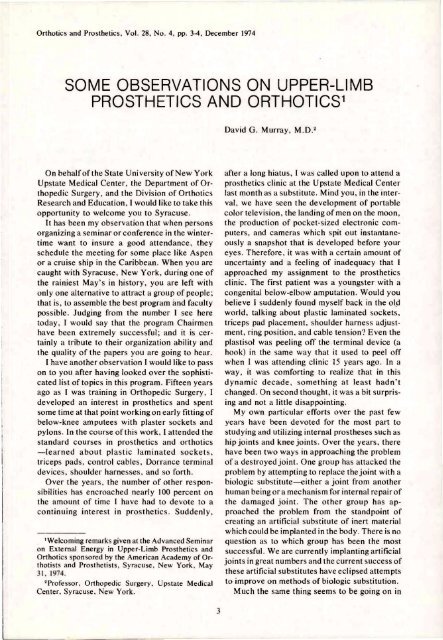Orthotics and Prosthetics
Orthotics and Prosthetics
Orthotics and Prosthetics
You also want an ePaper? Increase the reach of your titles
YUMPU automatically turns print PDFs into web optimized ePapers that Google loves.
SOME OBSERVATIONS ON UPPER-LIMB<br />
PROSTHETICS AND ORTHOTICS 1<br />
David G. Murray, M.D. 2<br />
On behalf of the State University of New York<br />
Upstate Medical Center, the Department of Orthopedic<br />
Surgery, <strong>and</strong> the Division of <strong>Orthotics</strong><br />
Research <strong>and</strong> Education, I would like to take this<br />
opportunity to welcome you to Syracuse.<br />
It has been my observation that when persons<br />
organizing a seminar or conference in the wintertime<br />
want to insure a good attendance, they<br />
schedule the meeting for some place like Aspen<br />
or a cruise ship in the Caribbean. When you are<br />
caught with Syracuse, New York, during one of<br />
the rainiest May's in history, you are left with<br />
only one alternative to attract a group of people;<br />
that is, to assemble the best program <strong>and</strong> faculty<br />
possible. Judging from the number I see here<br />
today. I would say that the program Chairmen<br />
have been extremely successful; <strong>and</strong> it is certainly<br />
a tribute to their organization ability <strong>and</strong><br />
the quality of the papers you are going to hear.<br />
I have another observation I would like to pass<br />
on to you after having looked over the sophisticated<br />
list of topics in this program. Fifteen years<br />
ago as I was training in Orthopedic Surgery, I<br />
developed an interest in prosthetics <strong>and</strong> spent<br />
some time at that point working on early fitting of<br />
below-knee amputees with plaster sockets <strong>and</strong><br />
pylons. In the course of this work, I attended the<br />
st<strong>and</strong>ard courses in prosthetics <strong>and</strong> orthotics<br />
—learned about plastic laminated sockets,<br />
triceps pads, control cables, Dorrance terminal<br />
devices, shoulder harnesses, <strong>and</strong> so forth.<br />
Over the years, the number of other responsibilities<br />
has encroached nearly 100 percent on<br />
the amount of time I have had to devote to a<br />
continuing interest in prosthetics. Suddenly,<br />
after a long hiatus, I was called upon to attend a<br />
prosthetics clinic at the Upstate Medical Center<br />
last month as a substitute. Mind you, in the interval,<br />
we have seen the development of portable<br />
color television, the l<strong>and</strong>ing of men on the moon,<br />
the production of pocket-sized electronic computers,<br />
<strong>and</strong> cameras which spit out instantaneously<br />
a snapshot that is developed before your<br />
eyes. Therefore, it was with a certain amount of<br />
uncertainty <strong>and</strong> a feeling of inadequacy that I<br />
approached my assignment to the prosthetics<br />
clinic. The first patient was a youngster with a<br />
congenital below-elbow amputation. Would you<br />
believe I suddenly found myself back in the old<br />
world, talking about plastic laminated sockets,<br />
triceps pad placement, shoulder harness adjustment,<br />
ring position, <strong>and</strong> cable tension? Even the<br />
plastisol was peeling off the terminal device (a<br />
hook) in the same way that it used to peel off<br />
when 1 was attending clinic 15 years ago. In a<br />
way, it was comforting to realize that in this<br />
dynamic decade, something at least hadn't<br />
changed. On second thought, it was a bit surprising<br />
<strong>and</strong> not a little disappointing.<br />
My own particular efforts over the past few<br />
years have been devoted for the most part to<br />
studying <strong>and</strong> utilizing internal prostheses such as<br />
hip joints <strong>and</strong> knee joints. Over the years, there<br />
have been two ways in approaching the problem<br />
of a destroyed joint. One group has attacked the<br />
problem by attempting to replace the joint with a<br />
biologic substitute—either a joint from another<br />
human being or a mechanism for internal repair of<br />
the damaged joint. The other group has approached<br />
the problem from the st<strong>and</strong>point of<br />
creating an artificial substitute of inert material<br />
which could be implanted in the body. There is no<br />
question as to which group has been the most<br />
successful. We are currently implanting artificial<br />
joints in great numbers <strong>and</strong> the current success of<br />
these artificial substitutes have eclipsed attempts<br />
to improve on methods of biologic substitution.<br />
Much the same thing seems to be going on in<br />
1Welcoming remarks given at the Advanced Seminar<br />
on External Energy in Upper-Limb <strong>Prosthetics</strong> <strong>and</strong><br />
<strong>Orthotics</strong> sponsored by the American Academy of Orthotists <strong>and</strong> Prosthetists, Syracuse, New York, M<br />
31, 1974.<br />
2<br />
Professor, Orthopedic Surgery, Upstate Medical<br />
Center, Syracuse, New York.
















